Few growth hacking strategies will have as much impact on your marketing and sales as building a growth team will.
If you want to see exponential and predictable results from your marketing, you need to build a growth team.
Doing that successfully is more about timing and context than anything else.
Tempo and circumstance are mostly overlooked — but they are absolutely critical. Here’s why:
Too fast, and you’ll lack the systems to be able to fully capitalize on channel hacks.
Too slow, and you’ll miss the rising tide and trends that could’ve brought you exponential results.
Your growth team is the linchpin that will help you pinpoint where you are (context) and when you are (timing) — and then execute the right leverage points to catapult you forward.
As soon as you’ve educated yourself on “growth hacking,” the first question is always:
“How and when do we build a growth team?”
To answer that, you have to take a step back so you can race forward.
You’ll recall from Part 1 that your business and products/services aren’t on a linear “lifecycle” of change. Your business exists in various states and phases.
Each “state” represents your attempts to most effectively match internal capacity and process with external customer or market demand.
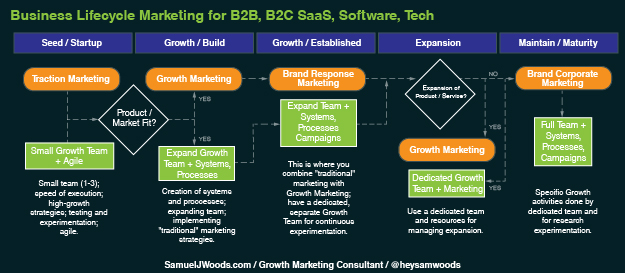
As such, your marketing systems and teams absolutely have to be agile.
When you’re asking yourself what growth marketing strategies you should deploy and when you should build a growth team, you always need to consider three things:
- What phase is your business in?
- What are you trying to accomplish?
- What are you existing capabilities?
Only when you know these three things do you consider the next step.
In the previous post, I briefly outlined what to do in each major business phase. In this article, we’re going to dive deeper into details of the activities for each phase.
In the Seed / Startup Phase, You Need: Traction Marketing
If you’re a startup that’s not yet reached sustainable product/market fit, you need to execute on traction marketing strategies only and find those customers or users fast.
Your whole growth team might consist of just one growth marketer (aka growth hacker), along with any creative or data support contractors.
Note how simplified the chart is in the Seed / Startup phase (below). This is purposeful, to keep you 100% focused on gaining traction before you start expending resources elsewhere.
Without traction, you have nothing to “hack” with your growth hacking.
“’Growth Hacking’ is a recognition that when you focus on understanding your users and how they discover and adopt your products, you can build features that help you acquire and retain more users, rather than just spending marketing dollars.”
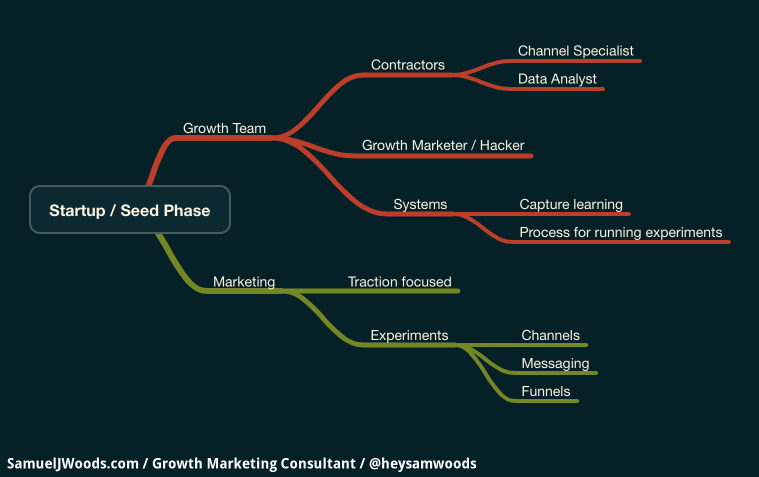
A great resource for you is the Growth Hacking Sourcebook. Pay special attention to the section on growth hacking case studies to start.
In the Growth / Build Phase, You Need: Growth Marketing + Build Growth Team
When you’ve hit product/market fit, it’s time to double-down on high-velocity growth strategies that capitalize on the profitable channels you’ve uncovered.
This is where most growth hacking tactics come into play. The idea is to discover effective marketing activities for acquisition through experimentation.
Your growth marketing in this phase should consist of focused campaigns that tend to bias Acquisition, Activation and Retention more than anything else.
As for your growth team, it’s still mostly your growth hacker (or growth marketer, as I prefer to be called) as team lead. But now is the time to capture his or her knowledge, put in place systems, document everything, and make your first full team member hire.
Notice the growth activity chart here gets a little more complex and leans more toward systems.
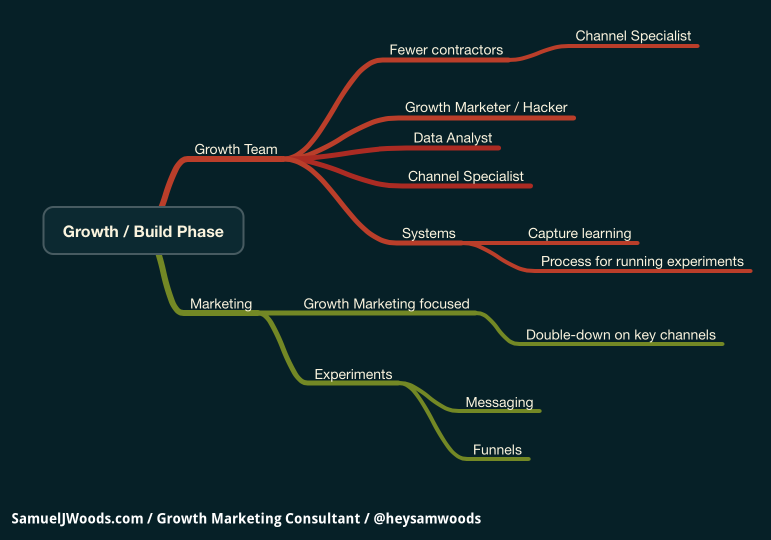
Scope out the great examples and case studies here for inspiration in the Growth / Build phase.
In the Growth / Established Phase, You Need: Brand Response Marketing
If you’re achieving growth, you’re well-established in a few key channels, and you’re consistently generating new users and customers, now and only now do you add brand marketing elements to the growth marketing mix.
You’ll be doing more traditional marketing activities in this phase, but it’s absolutely critical to maintain a growth mindset for every campaign you run. This means that even though you’re using more creative alongside expanding into traditional marketing tactics and channels, you never lose sight of tracking, data, and analytics.
Also in this phase, you can now add team members for traditional marketing to your growth team.
I would caution against silo-ing teams and splitting teams up. It’s much better to foster a “culture of growth hacking” in your growing marketing department.
Uber might be doing a lot of things wrong these days, but this is one thing they’re doing right.
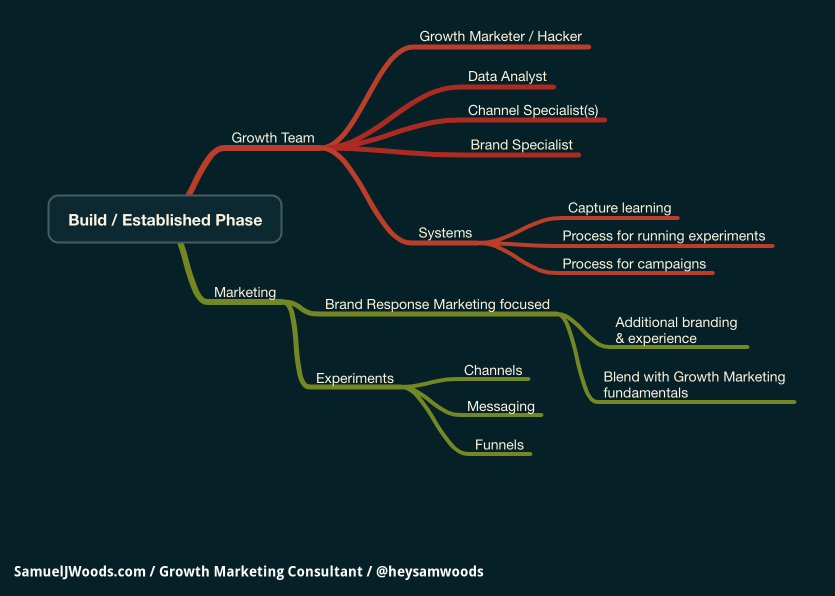
Need some ideas for a blended growth marketing / traditional marketing approach? Here are 101 of them.
In the Expansion and/or New Product Marketing Phase, You Need: Growth Marketing & Team
For established companies in the Expansion phase, you’re not always looking to capture market share through marketing — but marketing is still important.
Alongside your traditional marketing, you should still deploy growth marketing campaigns. The same systems and processes as earlier apply, but now you can take a more cyclical approach and run 90-180-day sprints on particular campaigns.
In this phase, your business is best served by using growth marketing for expansion projects and/or new products.
Your growth team should now be a separate, dedicated team consisting of 2-4 specialized team members who are exclusively focused on these activities.
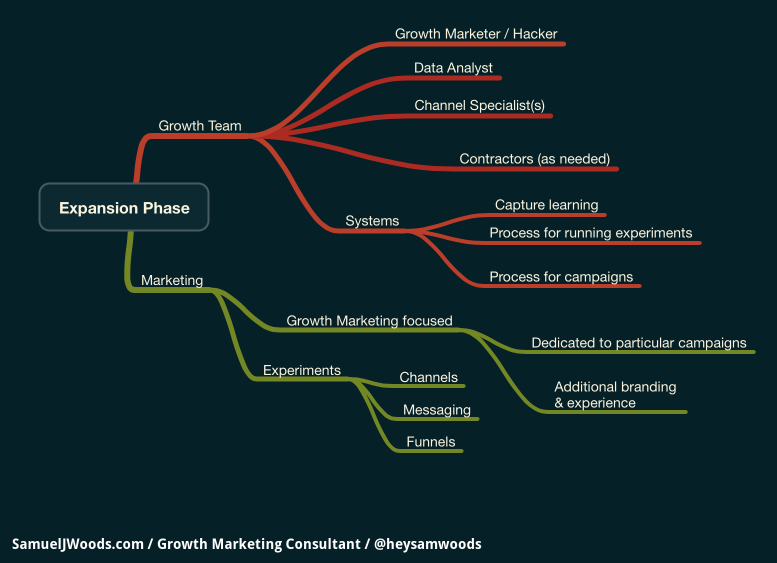
Just because your growth team becomes more structured in this phase, however, doesn’t mean you shouldn’t still prioritize a culture of growth throughout your organization. (B2B SaaS, I’m looking at you.) Don’t rest on your laurels.
For more on this, skip to point #5 in this article from Lincoln Murphy.
For #growthhacking tactics (and Growth Hackers themselves) to be effective, a culture of Growth must exist in the organization
— Lincoln Murphy (@lincolnmurphy) October 29, 2013
If You’ve Reached a Maintenance / Maturity Phase, You Need: Brand Corporate Marketing
Brand corporate marketing consists of more “traditional” campaigns, such as TV ads, brand-focused advertisement, and thought leadership — and all of these activities revolve around branding.
Where you would implement specific growth marketing tactics is if there’s a new initiative for products, services, or expanding market.
However, you should still engage in growth marketing within new channels and platforms.
You should keep a dedicated growth team (apart from your traditional team) that maintains experimentation and testing on any new channels or platforms that are created.
The tendency of businesses in a Maturity phase is to become risk averse — and you must fight this. Remember, you’re maintaining a culture of growth, and that doesn’t stop with your dedicated growth team. It extends from individual contributors to the marketing team to the VP of marketing, and beyond.
Continue to rely on analytics and data for data-driven decision making. You’ll rest assured that you’re making smart moves while still maintaining the all-important growth mindset.
In this phase, it’s vital for your continued success to keep trying new avenues for acquisition and capturing market share. You might feel like these things aren’t priorities anymore — but they must remain on your radar. If your brand goes stale, you will lose to competitors.
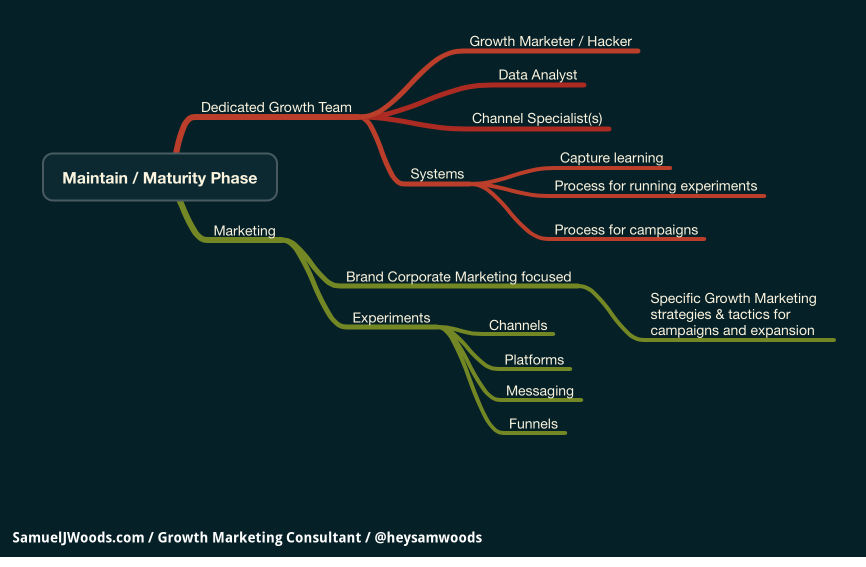
Building a Growth Team at The Right Time, for the Right Reasons
Getting your growth team right is more about timing and context than anything else.
Timing, in that you understand what trajectory your company is on, and what the trends are.
Signs of traction are encouraging but if you pull the trigger too soon, you end up with a bloated team that’s failing to execute and pull through on results.
Without a temp shift towards growth in the Building or Expansion phases, you’re also going to lose out.
Context, as in having an astute awareness of what phase your business is in.
Failure to recognize that you’re in a Traction phase will result in missed channel opportunities. Likewise, if you’re not building a team during the Growth / Build Phase, you won’t have robust yet agile systems and processes in place — and you’ll end up with random marketing experiments and a lot of waste.

